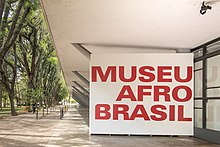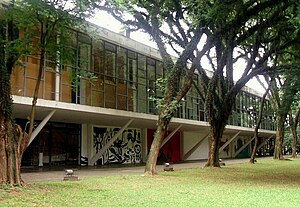Museu Afro Brasil
 | |
 | |
| Established | 2004 |
|---|---|
| Location | Ibirapuera Park, Brazil |
| Coordinates | 23°35′02″S 46°39′33″W / 23.58381°S 46.65908°W |
| Director | Emanoel Araújo |
| Website | www |
Museu Afro Brasil is a history, artistic and ethnographic museum dedicated to the research, preservation, and exhibition of objects and works related to the cultural sphere of black people in Brazil. It is a public institution held by the Secretariat for Culture of the São Paulo State and managed by the Museu Afro Brasil Association. The museum is located in Ibirapuera Park, a major urban park in São Paulo. The Manoel da Nóbrega Pavilion, designed by Oscar Niemeyer in 1959, houses the Museum. It holds around 6 thousands items and pieces including paintings, sculptures, photos, documents, and archives created between the 15th Century and the present day. The aggregation of pieces includes many works of the African and
History
Museu Afro Brasil was established in 2004 by Emanoel Araújo, former director and curator of the Pinacoteca do Estado de São Paulo, artist from Bahia. Araújo, since 2004 has been director of the museum.
Organization

The museum's collection is divided into several sections with different areas: Africa, labor, slavery, sacred and profane, Afro-Brazilian religions, history and memory, and the arts.
In the 20th century art section, there are important works made by
Museu Afro Brasil has the largest
Events
In 2014, for the tenth anniversary of the museum and concurrent with the
Gallery
-
Artur Timóteo da Costa
Study of the Craniums -
Joaquim José da Natividade
Bandeiras da Procissão de Cristo -
Santa Ifigênia
-
Jacques Etienne Arago
Punishment of slaves -
African Goddess Attie
See also
- .
References
- ^ Moyarte Archived 1 January 2015 at the Wayback Machine, Museu Afro-Brasil, O negro no Futebol Brasileiro – A arte e os artistas
- ^ Atdigital Archived 1 January 2015 at the Wayback Machine Ídolos do futebol estão na mostra do Museu Afro Brasil
- ^ Cultura Futebol Worldexpress "O Negro no Futebol Brasileiro – Arte e Os Artistas (Homenagem a Mário Filho)"






